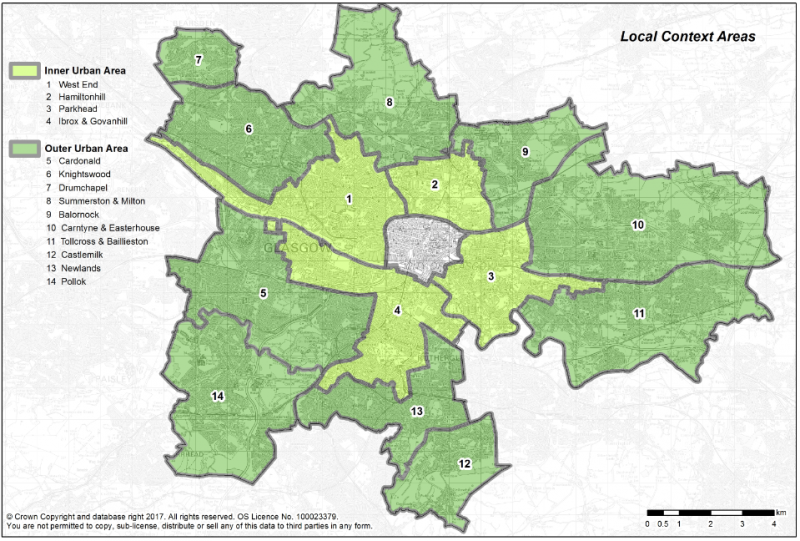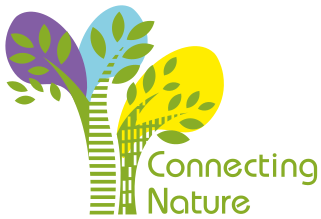Context
The City of Glasgow’s nature-based exemplar focuses on the delivery and implementation of the emerging Open Space Strategy (OSS) and its accompanying Local Context Analyses (LCAs). The Open Space Strategy exemplar sets out an approach to co-ordinate the various open space responsibilities to ensure well-managed, well-located and well-connected open spaces that operate as part of a wider green network, helping to deliver:
- greater awareness of the value of open space and of individual open spaces throughout Glasgow, informing their protection and management;
- a strategic rationale for the future use and management of the
- City’s open spaces, providing guidance on:
- priorities for investment in open space;
- opportunities for using other open spaces less intensively; and
- an informed basis on which to make decisions about open space disposal, where an open space may be of little value
- a basis for greater partnership working with other organisations that have an interest – e.g. with the NHS in how open spaces improve health;
- a framework for cross-departmental engagement and the co-ordination of spending plans to help secure best value; and
- a stronger basis for securing additional funding to help maximise open space benefits by promoting the value of open space and its benefits.
The Open Space Strategy Vision sets out that by 2050, there will be network of good quality, well-distributed, multi-functional open spaces, and connecting infrastructure, that contributes positively to:
- the City’s liveability, increasing its attractiveness as a place in which to live, work, study and invest;
- the health and wellbeing of the City’s human population and of its flora and fauna; and
- the long term resilience of the City in relation to the threats, and potential opportunities, arising from climate change and other external factors such as reducing budgets.
Communities will have access to good quality, multi-functional open spaces, that are used by all sectors of society, within a short walk of the home and to a wider, better integrated, network of green, blue (water) and grey (civic) spaces that provide multiple benefits for people and the environment.
The Open Space Strategy exemplar is structured to ensure these visions flow through all open space decisions to ultimately inform the future use of the city’s Open Spaces. Drawing on extensive survey and data analysis, the OSS developed a set of open space standards for Glasgow based upon the following:
- an Accessibility Standard - aimed at delivering access to a good quality open space, of >0.3ha, within a 400m walk of people’s homes;
- a Quality Standard – to ensure the open spaces used to meet the Accessibility Standard are of good quality in terms of usability and multi-functionality; and
- a Quantity Standard – to ensure there is enough open space, per head of population, in each part of the City. Different quantity standards apply to the Inner Urban Area (where residential population densities are higher) and the Outer Urban Area.
The views of the public and communities will also be critical in establishing current and future need. Public consultation responses to the OSS will start to provide an understanding of this but, in order to help focus on local open space issues, engagement will also take place on “Local Context” documents at the same time. These Local Context documents are being prepared in two stages. The Stage 1 documents set out what are considered to be the key open space issues in each of 15 local areas of the City (see map below) which, together, cover the whole of Glasgow.
 Stage 1 Local Contexts contain an initial analysis of the Accessibility, Quality and Quantity Standards in each area to identify potential deficiencies in each, together with other considerations such as the coverage of environmental designations and access to core paths. This tangible information will support meaningful engagement with communities on open space issues in their area.
Stage 1 Local Contexts contain an initial analysis of the Accessibility, Quality and Quantity Standards in each area to identify potential deficiencies in each, together with other considerations such as the coverage of environmental designations and access to core paths. This tangible information will support meaningful engagement with communities on open space issues in their area.
The Stage 2 Local Context process will consider all of the demands on open space identified through the OSS process, and how best these can be delivered in a holistic, multi-functional manner. Connecting Nature is focusing on the Stage 2 process.
Glasgow starts with a rich evidence base which helps the City identify locations that are suitable for, and can amplify, the benefits of NBS. One such example is the EU funded Sub Urban COST Action. This is a unique project recognising that the ground beneath cities is poorly mapped or understood. The Action established a network to co-ordinate, integrate and accelerate the world leading research into modelling the subsurface taking place in European institutions and to co-develop a Toolbox to enable subsurface knowledge to be widely disseminated. This was one of a series of local, national and international programmes that enabled Glasgow to take a refreshed look at NBS. The process helped the City start a process of breaking down departmental silos. City Council departments will work together to develop the Open Space Strategy and deliver its subsequent planning, management and project actions.
Climate change / adaption and sustainable use of resources
The Open Space Strategy exemplar and LCAs (stages 1 and 2) will allow open spaces to be identified in each area of the city that could benefit from Nature-based Solutions. The opportunities identified will be mapped and prioritized according to city and local community needs. The NBS will also help deliver an enhanced sense of place for local communities by building on the ‘Placemaking’ policy (and processes) which underpins the 2017 City Development Plan. Glasgow’s exemplar will allow for tactical interventions that help meet the City’s climate change adaption goals. Current projects derived from these objectives such as the provision of green infrastructure and the adoption of Surface Water Management plans, where NBS such as rain gardens feature. These projects are helping to bring multifunctional spaces -with benefits to people, biodiversity and the city’s Placemaking- to fruition.
A small scale nature-based solution pilot was developed at Lambhill Stables. An old mining site was turned into a series of elevated community gardens, filtration systems and wetlands, managed by a public-civic partnership. The project features a community centre, which hosts reskilling and rehabilitation programmes, a community kitchen, and an art studio with gardening and greening programs. The Lambhill Stables project, within a deprived neighbourhood of the city, provides sound experience for the city to scale-up and expand further nature-based projects throughout the city, with a focus on climate change mitigation and adaptation.
Health, wellbeing and placemaking
The City’s Open Space Strategy exemplar, LCAs and ‘Opportunity Mapping’ will leverage data sets, surveys and local knowledge to enhance multifunctional open spaces throughout the city. By seeking to meet the new standards, Glasgow’s open space will be Reconnected, Reinvented, Reconfigured, Respected, Repaired, Refined, Reinforced or Reactivated accordingly. The City’s open spaces - whether blue, grey or green - will aim to provide not just a space for recreational use but also spaces that are climate ready, green corridors, allow for active travel, and/or quiet contemplation. NBS are recognised for their potential in alleviating some the city’s persistent problems. For example, certain areas of Glasgow, such as the City Centre, have poor air quality due to the heavy traffic. Improved multifunctional open space, incorporating NBS, can act as a ‘green lung’ helping to improve the health and wellbeing of the citizens.
Glasgow’s nature-based solution exemplar will contribute to the City Development Plan’s Placemaking objectives of creating more inviting, walkable neighbourhoods that promote social interaction, improve visual amenity, promote wellbeing and increased ‘sense of place’.
Social cohesion and community engagement (co-creation)
As noted above, the Open Space Strategy exemplar vision recognises that better integrated, network of green, blue and grey spaces provide multiple benefits for people and the environment. The exemplar will seek to incorporate community participation as much as possible, as the co-creation processes will help facilitate social cohesion and ‘sense of place’ which are critical to the well-being of local residents, as well as encouraging positive relationships with spaces. These relationships can also foster better long term care and stewardship of any of the city’s open spaces. In addition to providing attractive places to socialise, move around and do business, the City seeks to ensure access to open spaces for everyone. This includes the needs of disabled people, minority ethnic groups, children, young people and their carers, older people and economically or socially disadvantaged groups. The potential offered by open space to enhance people’s health and wellbeing is undeniable. Good quality places with a focus on Placemaking principles that respond to people’s needs, reflect local distinctiveness will contribute positively to people’s quality of life and sense of well-being. This provides the opportunity to improve mental health and contribute to social cohesion, which are vitally important in a large, post-industrial city like Glasgow.
Economic Development
The City of Glasgow’s vacant and derelict land register and fund prioritises the remediation of land and the need for environmental improvements to remove the feeling of blight in communities where VDL is significant. This is important, given that over 50% of Glasgow’s population lives within 500m of VDL. The OSS and LCAs will help to guide the VDL fund to remediate and / or redevelop sites by using NBS to unlock economic and/or amenity benefits for the local community.
How city of Glasgow is adding value through the Connecting Nature programme
In conjunction with the City’s Strategic Plan, Economic Strategy and City Development Plan, Glasgow’s exemplar will seek to provide, and encourage, spaces which can facilitate enterprise, where possible. Connecting Nature will be focusing on how these opportunities can facilitate not only the initial delivery of NBS but how these opportunities can be self-funded and self-sustaining in the long term.
Connecting Nature is focusing on the Stage 2 process of the Open Space Strategy exemplar to help identify opportunities to deliver “nature based solutions” that can help tackle some of the city’s challenges (e.g. climate change) whilst delivering benefits such as increased biodiversity, energy production, the promotion of social cohesion, and the reduction of health inequalities. This Stage 2 work will see Connecting Nature add value through technical nature-based expertise and guidance on institutional and organisational innovation to address silos with the city council as well as partnership building. Community engagement will again be a key part of the process. Connecting Nature will help deliver GIS-based ‘Opportunity Mapping’ which will facilitate the identification of priority areas for improvement or re-use for alternative purposes, where appropriate. At the start of the project the Connecting Nature city lead convened a range of colleagues across different departments and external partners at regional and national level to brainstorm opportunities and ideas for how the city could embed nature-based solutions. This process of seeing how to align different operational departments with NBS as the coherent link is a new way of working for GCC.
